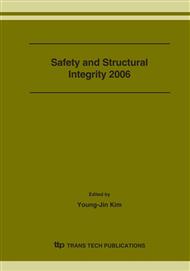p.129
p.135
p.141
p.147
p.157
p.163
p.169
p.175
p.181
Development of an Integrity Evaluation System for Steam Generator Tubes in a Nuclear Power Plant
Abstract:
Steam generators working in nuclear power plants convert water into steam from heat produced in the reactor core and each of them contains from 3,000 to 16,000 tubes. Since these tubes constitute one of primary barriers under radioactive and high pressure condition, the integrity should be maintained carefully during the operation. The objective of this research is to introduce an integrity evaluation system for steam generator tubes as a substitute of well-trained engineers or experts. For this purpose, a couplet examination has been carried out on the complicated evaluation procedure and an efficient system named as STiES was developed employing three representative integrity evaluation methods: fracture mechanics analysis (crack driving force diagram and J-integral/Tearing modulus method) and limit load method. Exemplary analyses for steam generator tubes with various types of flaws showed good applicability of the proposed integrity evaluation system. So, it is anticipated that the system can be used for the calculation of reference pressure to decide either the continued operation or repair until next outage.
Info:
Periodical:
Pages:
157-162
Citation:
Online since:
February 2007
Authors:
Price:
Сopyright:
© 2007 Trans Tech Publications Ltd. All Rights Reserved
Share:
Citation:


